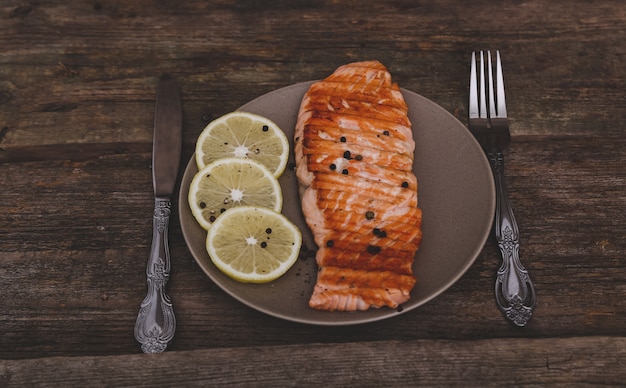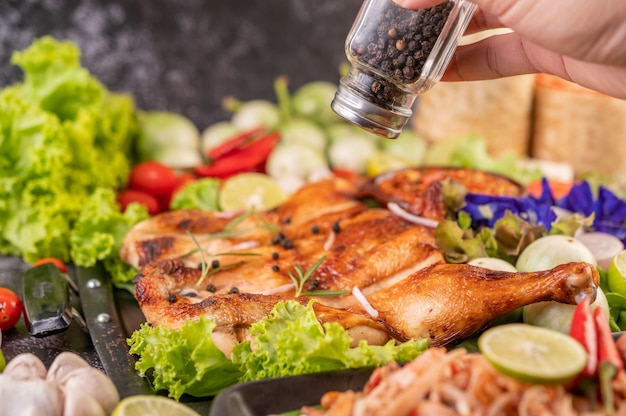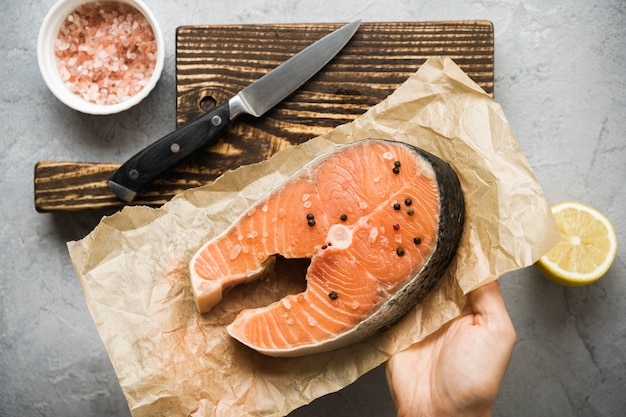There’s a certain magic to perfectly grilled salmon. That delicate, flaky texture, the rich, buttery flavour, and the hint of smoky char – it’s a symphony of taste and texture that makes my heart sing. But achieving that perfect grill-mark perfection can be tricky. You don't want dry, overcooked fish, or worse, raw bits lurking in the middle. No, you want that gorgeous golden crust and juicy, succulent flesh that melts in your mouth. So, grab your apron, fire up the grill, and let's embark on a journey to conquer the art of grilling salmon, together!
(Part 1) The Fish: Choosing Your Salmon

You know what they say – you can’t make a silk purse out of a sow’s ear, and the same goes for salmon. The quality of your fish is absolutely paramount. There’s nothing more frustrating than spending hours prepping, only to end up with a disappointing result. So, let's start by choosing the right salmon, the star of our show.
Choosing the Right Salmon
First, let's talk about the flavour profile you're aiming for. farmed salmon tends to be milder, with a more delicate flavour, while wild salmon is a bolder choice with a more intense, briny taste. Personally, I adore the richness of wild salmon, but it can be a bit pricier. No judgement here – farmed salmon is still a fantastic option. Just pick one that’s fresh and vibrant, with bright, shiny skin. The flesh should be firm and springy to the touch, not mushy. Think of it like a well-toned muscle – you want a firm, healthy fish.
salmon cuts and Sizes
Now, let's talk about the cut. For grilling, you’ll want a nice thick fillet, usually about 1-1.5 inches thick. This gives you enough surface area to achieve that beautiful char without drying out the inside. If you’re feeling adventurous, you can also try grilling salmon steaks, which are essentially thick, boneless slabs. They're a great option for larger gatherings. But for this guide, we’ll focus on the classic fillet, the workhorse of salmon grilling.
Prepping the Salmon
Once you’ve got your salmon, it’s time to prep it. Rinse it gently under cold water and pat it dry with paper towels. You can remove the skin if you want, but I prefer leaving it on for grilling, as it helps keep the fish moist and adds a nice bit of texture. Next, season your salmon to your heart’s content. I like to keep things simple with just salt and pepper, allowing the natural flavour of the salmon to shine. But feel free to get creative with herbs and spices! Remember, a little goes a long way. You don't want to overpower the delicate flavour of the salmon.
(Part 2) The Grill: Your Weapon of Choice

You’ve got the salmon, now you need the right weapon – the grill! It's your culinary battleground, so choose wisely. There are loads of different types out there, from gas to charcoal to even electric grills. Each has its own quirks and benefits, so it really depends on your preferences and what you have on hand. Let's take a look at each one and see which one fits your grilling style.
Gas Grills: The Pros and Cons
Gas grills are incredibly convenient. They heat up fast, are easy to control, and you can achieve consistent results. They're also generally less messy than charcoal grills. Plus, they're great for those who live in areas where open fire is restricted. But, they lack that smoky flavour that comes with charcoal. I also find that some gas grills can produce uneven heat, which can be a pain when grilling delicate salmon. You might end up with unevenly cooked fish, which is definitely not ideal.
Charcoal Grills: The Kings of Smoke
Charcoal grills, on the other hand, are all about that smoky flavour. They give your salmon a gorgeous char and add a depth of flavour that you just can’t get with gas. Plus, there’s something really satisfying about cooking over live fire. It's almost primal, connecting you to the ancient tradition of cooking over fire. However, they can be a bit of a hassle. They take longer to heat up, require more effort to control the temperature, and the cleanup can be a real chore. But for those who appreciate the smoky flavour and the ritual of grilling, it's worth the effort.
Electric Grills: The Modern Solution
Electric grills are perfect for those who don’t have outdoor space or want a more convenient option. They’re easy to use, clean, and produce consistent heat. You can use them even in your apartment without worrying about smoke alarms going off! However, they don’t offer the same smoky flavour as charcoal grills, and they can sometimes lack the intensity of a gas grill. But, for those who want a fuss-free grilling experience, they’re a great choice.
Preparing Your Grill
No matter which type you choose, make sure your grill is clean and preheated before you start grilling. A clean grill ensures even heat distribution, while preheating ensures that your salmon gets a nice crust without sticking to the grill grates. You'll also want to oil the grates to prevent sticking, ensuring a smooth grilling experience.
(Part 3) Grilling Techniques: Mastering the Heat

Now, you’re ready to grill! But before you throw that beautiful salmon on the hot grates, let's talk about grilling techniques. We want a crispy exterior and a juicy, cooked-through interior. It’s all about understanding how heat affects the fish and how to manage it effectively.
Direct Grilling: For That Crispy Crust
Direct grilling is a classic technique for achieving a crispy crust. It involves placing the salmon directly over the heat source. This method is great for smaller fillets that cook quickly. But be careful not to overcook it, as it can become dry and tough. Keep a close eye on your fish during direct grilling, and be ready to flip it as needed to ensure even cooking.
Indirect Grilling: For Gentle Cooking
For larger fillets or those that you want to cook more gently, indirect grilling is the way to go. It involves cooking the salmon away from the direct heat, using the cooler side of the grill. This method ensures even cooking and a more moist interior. You can use a heat diffuser, which sits on top of the heat source, or simply place the salmon in a less intense part of the grill. This method works well for thicker fillets, as it allows them to cook through without burning on the outside.
The Two-Zone Method: The Best of Both Worlds
For maximum control, I always use the two-zone method. This involves creating a hot zone and a cooler zone on your grill. You can achieve this by using high heat on one side and low heat on the other. This allows you to sear the salmon over high heat to get a nice crust and then move it to the cooler side to cook through without overcooking. It's the perfect combination of direct and indirect grilling, giving you the best of both worlds.
(Part 4) Mastering the Timing: Knowing When It’s Done
The real art of grilling salmon is knowing when it’s done. You want a beautiful golden crust and a flaky, moist interior. It’s all about getting that perfect balance. Don’t overcook it, or you’ll end up with dry, tough fish. It's a delicate dance, my friends, and timing is key. Here's how to tell when it's ready:
The Fish Flakes Test
One of the most reliable ways to know when salmon is done is by using the fish flakes test. Gently press the surface of the fish with a fork. If the flakes easily separate, it’s cooked through. If it resists, it needs more time. This test is a good visual and tactile indicator of doneness, and it's surprisingly accurate.
internal temperature
For a more scientific approach, you can use a meat thermometer. Salmon is cooked through when the internal temperature reaches 145°F (63°C). Be careful not to overcook it, as it can become dry and tough. The thermometer provides a reliable way to ensure that the salmon is cooked to a safe temperature.
Visual Clues
You can also rely on visual clues. The surface of the salmon should be golden brown and slightly charred. The flesh should be opaque, not translucent. And the edges of the fish should be firm to the touch. These visual cues are a good indication of doneness, and they can be helpful if you don't have a thermometer on hand.
Timing Is Key
The cooking time will vary depending on the thickness of the fillet and the heat of the grill. A general rule of thumb is 4-6 minutes per side for a 1-inch thick fillet on medium heat. However, always keep an eye on the fish and use your best judgement. It's always better to err on the side of caution and undercook it slightly, as you can always grill it a little longer if needed.
(Part 5) Resting and Serving: Allowing the Flavours to Bloom
Once the salmon is cooked, it’s crucial to let it rest for a few minutes before serving. This allows the internal juices to redistribute, ensuring a juicy and tender fish. While it’s resting, you can prepare your sides and create the perfect setting for your culinary masterpiece.
Resting the Salmon
Transfer the cooked salmon to a plate or cutting board and loosely cover it with foil. Let it rest for 5-10 minutes before serving. This allows the fish to relax, reabsorb its juices, and become more tender. It also prevents the fish from drying out, ensuring that every bite is moist and flavorful.
Choosing the Perfect Sides
Now, it’s time to decide on the perfect accompaniments for your grilled salmon. A classic choice is roasted vegetables, like asparagus or broccoli, which complement the fish’s flavour and provide a vibrant colour contrast. You can also try a creamy potato gratin, a simple green salad, or even a bed of fluffy rice. Let your imagination run wild! The key is to choose sides that balance the flavours and textures of the salmon.
Serving with Style
To truly elevate your grilled salmon, consider how you’ll present it. A simple white plate allows the salmon’s natural beauty to shine. You can add a touch of elegance with a sprig of fresh dill, a slice of lemon, or a drizzle of olive oil. Remember, it’s all about creating a visually appealing and delicious dish. Presentation is everything, and a beautiful plate will make your culinary creation even more enjoyable.
(Part 6) Going Beyond the Basics: Flavor Variations
So far, we’ve focused on the classic grilled salmon experience. But there’s a whole world of flavour variations waiting to be explored. Let’s get creative and try some exciting new recipes that will take your grilled salmon to the next level!
Mediterranean salmon with lemon and Herbs
This vibrant recipe combines the freshness of lemon with the aromatic flavours of herbs. Simply brush the salmon fillets with a mixture of olive oil, lemon juice, garlic, and chopped fresh herbs like rosemary, thyme, and oregano. Grill as usual, and you’ll be transported to the sunny shores of the Mediterranean with each bite. This recipe is perfect for a light and refreshing meal, especially during the summer months.
Spicy Salmon with Chilli and Ginger
For those who like a little heat, this recipe is for you. Combine minced ginger, chilli flakes, soy sauce, and a touch of honey to create a fiery marinade. Marinate the salmon for at least 30 minutes before grilling, and prepare for a flavour explosion that will tantalise your taste buds. This recipe is perfect for those who like their food with a kick.
smoked salmon with maple glaze
This recipe combines the smoky flavour of grilled salmon with the sweetness of maple syrup. Simply brush the salmon fillets with a mixture of maple syrup, soy sauce, and a pinch of smoked paprika. Grill as usual, and you’ll be amazed by the delicious combination of sweet and smoky flavours. This recipe is perfect for those who enjoy sweet and savory combinations.
(Part 7) Grilled Salmon: A culinary journey
Grilling salmon isn’t just about cooking a fish; it’s about embarking on a culinary journey. It’s about exploring different flavours, experimenting with techniques, and creating memorable dishes. Each time you grill salmon, it’s an opportunity to learn, to grow, and to discover new possibilities. It's about turning a simple dish into a culinary adventure.
The Joy of Experimentation
Don’t be afraid to experiment with different flavours and seasonings. Try adding a squeeze of lime, a sprinkle of cayenne pepper, or a drizzle of honey. The possibilities are endless. It’s about finding what you love and creating your own signature dish. Don't be afraid to get creative and let your taste buds guide you. It's your culinary playground, so have fun with it.
Sharing Your Passion
One of the most rewarding aspects of cooking is sharing your passion with others. Invite friends over for a grilled salmon feast, and share your newfound knowledge. Talk about the different techniques, the flavour variations, and the joy of grilling. It’s about creating a shared experience and spreading the love of good food. Cooking is a wonderful way to connect with others, and sharing your passion for grilling salmon can be a truly enriching experience.
The Art of Simplicity
Despite the endless possibilities, sometimes the most satisfying dishes are the simplest ones. A perfectly grilled salmon fillet with a sprinkle of salt and pepper can be incredibly delicious. It’s about focusing on the quality of the ingredients and letting the natural flavours shine through. Sometimes, less is more, and a simple, perfectly executed dish can be incredibly satisfying. It's a testament to the power of good ingredients and the art of grilling.
(Part 8) FAQs: Your Grilled Salmon Queries Answered
You’ve learned about choosing the right salmon, mastering grilling techniques, and exploring flavour variations. But what about those burning questions that keep popping up? Let’s tackle some common FAQs about grilling salmon:
1. What Happens If My Salmon Sticks to the Grill Grates?
If your salmon sticks to the grill, it’s usually because the grill grates aren’t hot enough or the fish wasn’t properly oiled. To prevent sticking, make sure your grill is preheated and lightly oil the grates before grilling. You can also brush the salmon with a little oil to help it release easily. Ensuring that the grates are properly oiled and hot is crucial for preventing sticking and ensuring a smooth grilling experience.
2. How Can I Prevent My Salmon From Drying Out?
To prevent salmon from drying out, use indirect grilling or the two-zone method, which allows the fish to cook more gently. You can also brush the salmon with a marinade or glaze to help retain moisture. And always let the salmon rest for a few minutes before serving. These techniques help to ensure that the salmon cooks evenly and stays juicy and tender.
3. What Can I Do With Leftover Grilled Salmon?
Leftover grilled salmon is a delicious base for many dishes. You can flake it and use it in salads, sandwiches, or wraps. You can also use it to create a hearty salmon chowder or a creamy salmon pasta sauce. The possibilities are endless! leftover salmon is a culinary treasure, offering a variety of delicious possibilities.
4. Is It Safe to Grill Salmon When It’s Still Frozen?
It’s not recommended to grill salmon while it’s still frozen. The fish will cook unevenly, and the outside will likely burn before the inside is cooked through. It’s best to defrost the salmon completely in the refrigerator before grilling. Defrosting the salmon properly ensures that it cooks evenly and safely.
5. Can I Marinate Salmon For Longer Than Recommended?
While marinating salmon for longer can enhance the flavour, it’s important to note that prolonged marinating can make the fish too salty or break down the flesh. It’s best to stick to the recommended marinating time, which is usually 30 minutes to an hour. If you’re unsure, err on the side of caution and shorten the marinating time. Marinating can enhance the flavour, but it's important not to overdo it.
Conclusion
Grilling salmon is a skill that can be mastered with a little practice and a dash of patience. By choosing the right salmon, understanding grilling techniques, and experimenting with flavours, you can create culinary masterpieces that will impress your friends and family. So, go forth, embrace the smoky goodness, and enjoy the delightful journey of grilled salmon!
Everyone is watching

Prime Rib Roast Cooking Time Chart: Per Pound Guide
Cooking TipsPrime rib roast. Just the name conjures images of lavish dinners, crackling fires, and hearty laughter. It’s ...

How Long to Bake Potatoes in the Oven (Perfect Every Time)
Cooking TipsBaked potatoes are a staple in my kitchen. They're incredibly versatile, delicious, and surprisingly easy to m...

Perfect Rice Every Time: The Ultimate Guide to Cooking Rice
Cooking TipsAs a self-proclaimed foodie, I've always been a bit obsessed with rice. It's the foundation of countless cuisi...

The Ultimate Guide to Cooking Asparagus: Tips, Techniques, and Recipes
Cooking TipsAsparagus. The mere mention of this spring delicacy conjures up images of vibrant green spears, crisp and burs...

Ultimate Guide to Cooking the Perfect Thanksgiving Turkey
Cooking TipsThanksgiving. Just the word conjures up images of overflowing tables laden with delicious food, the scent of r...
